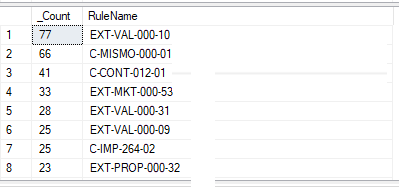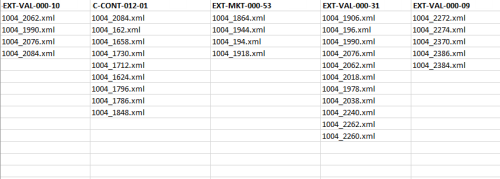How do you select just one cell from one row on one column in a table?
-
January 31, 2019 at 6:47 pm
So this is what I am tryng to do. The goal is to produce a temp table where the columns are numbered 1 to 10.
The following sql statements produces PART of the data that is required content:select Count(*) as _Count,RuleName from CompDiffTable group by RuleName order by _Count desc
select Count(*) as _Count,RuleName INTO #DATA_DrillReport from CompDiffTable group by RuleName order by _Count descSELECT * FROM #DATA_DrillReport order by _Count desc
DROP TABLE #DATA_DrillReport

This creates an ordered table where a column of RuleNames ordered the way I want.
Now, lets suppose one of those rule names is GIZANTHAPUS (it is not, but let's just say it is).
So, as I test to get a FileID associated with GIZANTHAPUS, I tried this mishapen SQL query:SELECT FileId FROM CompDiffTable where RuleName = "GIZANTHAPUS"The syntax is wrong, but you get the idea.
It should have returned a list of FileId's where the RuleName is GIZANTHAPUS
This test was an attempt to step towards createing a query where "GIZANTHAPUS" is replaced by a variable repesenting the RuleName from the first query.
What I really want in the final temp table is all the FileId's that are associated with the RuleNames. That is the content of the final temp table.I want my final temp table to contain data where the queried RuleNames are are in the column order that they would appear as rows in the query:
SELECT * FROM #DATA_DrillReport order by _Count desc
And the rows would contain the FileID's associated that with that RuleName.

I have seen a select statement that produces a table actually have nested select statement for each column. This, I think is what I need to do. This picture shows such a select statement where each column of the temporary table is made by its own select statement. This is what I want to do. The only thing I think I am missing now is how to make each of these nested select statements query just ONE row of the first table I made under the column for RuleName. This pic is just an example of this nested select pattern and now representative of what my query will look like -
February 1, 2019 at 10:35 am
Please provide sample data and expected results. Read the first link in my signature to learn how.
Drew
J. Drew Allen
Business Intelligence Analyst
Philadelphia, PA
Viewing 2 posts - 1 through 1 (of 1 total)
You must be logged in to reply to this topic. Login to reply

